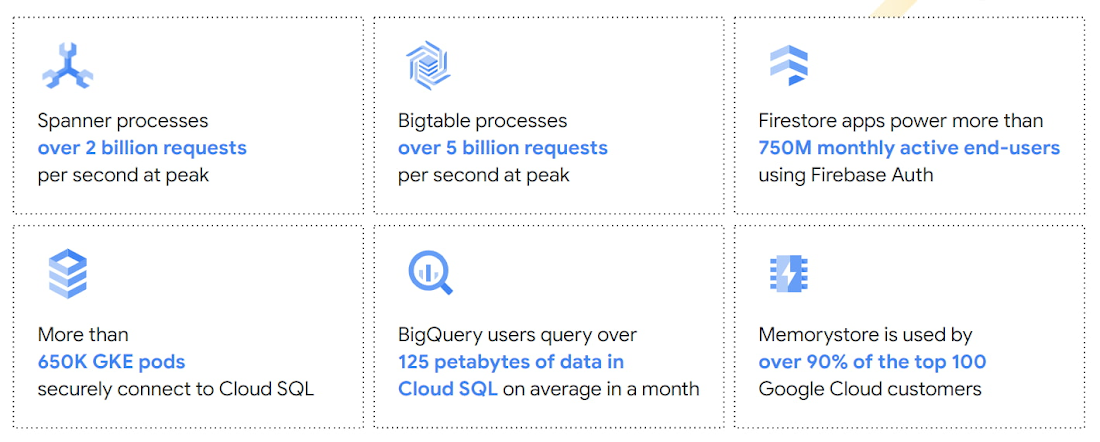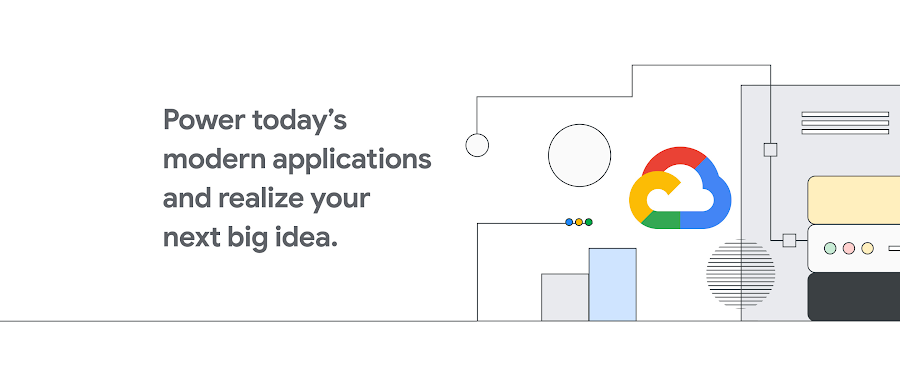Google Cloud’s key investment areas to accelerate your database transformation

Andi Gutmans
VP/GM, Data Cloud, Google Cloud
The sky’s the limit when it comes to reimagining digital experiences. At least, that’s how consumers view it. Applications are about more than delivering a service. Today’s customers also expect them to be lightning fast, personalized, and easy to use.
Operational databases power your most important applications and, therefore, your business. But, choosing an operational database could mean the difference between building a great customer experience or coming up short. IDC research estimates that enterprises will derive over 25% of their revenue from digital products, services, and experiences by 2026—but only if they get digital innovation right.1
Google Cloud databases are simply unmatched for speed, scale, security, and reliability. With just a few clicks and minimal overhead, organizations of any size can get started with operational databases to deliver the best possible experiences for customers from anywhere.


We’re committed to helping you accelerate your digital transformation journey and are investing in six key areas to remove the complexity of running your databases, so they’re simple to use and operate.
Here are the six areas we are investing in:
#1 Reliability and availability
Today’s always-on business models require highly reliable, continuously available, and seamlessly scalable applications that ensure every user in every region has a positive experience. Our cloud-native databases, Cloud Spanner, Cloud Bigtable, and Firestore, offer industry-leading availability SLAs of up to 99.999%. They also offer automatic sharding, zero-touch global replication, and no maintenance downtime.
We’ve also been enhancing Cloud SQL, Google Cloud’s fully managed relational database service for running MySQL, PostgreSQL, and SQL Server workloads. Cloud SQL’s maintenance downtime is on average 80% shorter than it was 12 months ago, which is faster than comparable solutions on the market. With the recent addition of SQL Server Cross-Region Replicas, Cloud SQL provides you with multi-region scalability and disaster recovery options. And with controls such as maintenance deny period and advance notification, Cloud SQL is a true industry leader.
#2 Security and governance
Security and governance are key concerns for every industry due to the increasing growth and complexity of data, regulatory and compliance requirements, and escalating cyberattacks. That’s why we provide robust tools and technology to protect and govern your data throughout its lifecycle. All data within Google Cloud is automatically encrypted in transit and at rest. Our databases offer standardized authentication and authorization with Identity and Access Management (IAM), and we are continuing to make investments across the portfolio.
For Cloud SQL for SQL Server, we've enabled cross-project integration to authenticate via Managed Microsoft Active Directory. We continue to invest in more rigorous controls, such as Customer Managed Encryption Keys, which provides you with complete encrypted control of instance data and backups as well as the ability to rotate keys on your own schedule.
#3 Integration with Google Cloud ecosystem
Regardless of their size, many organizations struggle with data silos that hinder business operations and limit the ability to make informed business decisions. At Google Cloud, we provide a highly integrated and unified ecosystem of industry-leading cloud services, including BigQuery, Google Kubernetes Engine, and Cloud Functions. These services ensure that you can break down operational silos, build data pipelines, generate real-time insights, and make better business decisions.
We’re continuing to make our data cloud portfolio integrated across the data lifecycle. We announced Datastream to replicate and synchronize data across heterogeneous databases and applications, which supports real-time analytics, database replication, and event-driven architectures. With Datastream, you can easily and seamlessly deliver change data streams from your Oracle and MySQL databases into Google Cloud’s services. This includes BigQuery, Cloud SQL, Google Cloud Storage (GCS), and Spanner, with support for additional data sources and destinations on the way.
This week, we announced that Spanner change streams is coming soon. With change streams, you can track inserts, updates, and deletes to your Spanner database and write the changes to downstream systems in real-time at scale. You can easily replicate changes from Spanner to BigQuery for real-time analytics, trigger downstream application behavior using Pub/Sub, or store changes in Google Cloud Storage (GCS) for compliance purposes.
#4 Financial governance and cost
We believe that getting the best price for cloud services shouldn’t require sophisticated forecasting models or unnecessary financial risk. We’ve made many investments across the portfolio to help you understand and better manage your cloud costs. For example, we recently launched Bigtable Autoscaling, so you can automatically add or remove capacity in response to the changing demands of your workloads, and only pay for the capacity you need. This also reduces your management overhead so you can spend more time on your business and less time managing your infrastructure.
We introduced Cloud SQL cost recommenders with Active Assist, empowering developers to better optimize and manage costs. It helps you detect idle instances, rightsize overprovisioned instances, and leverage Committed Use Discounts (CUDs).
We already offered CUDs for Cloud SQL and recently announced them for Spanner. Committed Use Discounts reward customers with steady-state workloads and predictable usage in a way that’s easy to use and can accommodate changes in your database environment. For Spanner, for example, you can get up to a 40% discount on Spanner compute capacity by purchasing CUDs.
To continue democratizing access to Spanner, we introduced granular instance sizing which allow you to get started with Spanner at a tenth of the cost of regular instances, equating to approximately $65 per month.
#5 Observability
Developers are the backbone of application modernization and need the ability to move faster to create more innovative applications. We’ve been investing in database observability features like Cloud SQL Insights and Key Visualizer to help developers address database performance problems, all at no extra charge.
Last year, we launched Cloud SQL Insights for PostgreSQL, a simple, open tool that helps developers quickly understand and optimize the performance of Cloud SQL. We designed Cloud SQL Insights using open standards, with world-class visualizations and modern architectures, such as microservices, in mind. Insights has become one of the fastest adopted new capabilities in Cloud SQL. And this week, we announced the preview of Cloud SQL Insights for MySQL. Insights is available at no additional cost for the last seven days of your database history.
Many organizations continue to choose Cloud SQL for building apps quickly. For example, Wayfair moved their SQL Server workloads to Google Cloud without derailing their team of over 3,000 engineers, their tens of millions of customers, or their 16,000 supplier partners.
#6 Migrations
We’ve been focused on simplifying migrations to the cloud because we know how complex migrations can be without proper tooling. Database Migration Service (DMS) is an easy-to-use service that makes migrations to Cloud SQL faster, more predictable, and more reliable. More than 85% of the migrations using Database Migration Service are underway in less than an hour. Database Migration Service currently supports MySQL and PostgreSQL databases, with support for SQL Server migrations coming soon.
Our customers want to modernize their Oracle databases to Cloud SQL for PostgreSQL, and now you can reduce your costs and dependence on proprietary Oracle databases. This week, we announced that Database Migration Service supports Oracle to PostgreSQL schema and data migration. This is available now in preview, and offers a simple migration path from Oracle to PostgreSQL. DMS integrates with the Ora2Pg open-source tool for schema conversion and provides serverless data replication and monitoring for your migrations.
We also announced this week the General Availability of Live Migrations from Apache HBase to Cloud Bigtable. Bigtable is HBase API compatible and is a popular choice for modernizing HBase clusters for better performance, scale, manageability, and cost savings. We released several features for live migrations, including a Schema Translation Tool, Replication Library, and Migration Validation Tool, with the aim to make HBase to Bigtable migrations easier and faster for you.
Finally, we announced the Database Migration Program. This program is designed to help make your migration experience fast, easy, and cost-effective. Get assessments, tooling, best practices, and resources from our network of specialized database technology partners. We’re also providing financial incentives to offset migration costs, helping you to quickly and cost effectively migrate your databases to Google Cloud. Start here today with the Database Migration Program.
We couldn’t be more excited to be on this journey with you. Are you ready to migrate, modernize, and transform for the future? Learn more about Google Cloud database services that can help you deliver transformative experiences for your users.
1. IDC, FutureScape: Worldwide Future of Digital Innovation 2022 Predictions, Doc #US47148621, October 2021



